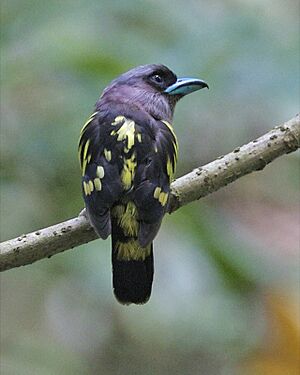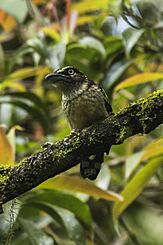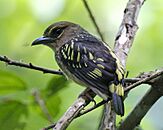Banded broadbill facts for kids
Quick facts for kids Banded broadbill |
|
|---|---|
 |
|
| Male of the subspecies pallidus | |
| Conservation status | |
| Scientific classification | |
| Genus: |
Eurylaimus
|
| Species: |
javanicus
|
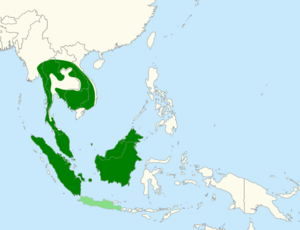 |
|
| Range of the banded broadbill; nominate subspecies in light green and other subspecies in dark green | |
| Synonyms | |
The banded broadbill (Eurylaimus javanicus) is a colorful bird found in Mainland Southeast Asia and the Greater Sunda Islands. It belongs to the Eurylaimidae family, known as typical broadbills. This bird lives in different kinds of forests, including rubber plantations and special tree groves. It mostly stays in lowland areas.
The banded broadbill is a striking bird, about 21.5–23.0 cm (8.5–9.1 in) long. It's hard to mistake it for another species because of its unique look. It is mostly purplish-red with black wings that have yellow stripes. It also has a bright blue beak, a blackish face, and a greyish chin and upper chest. Female broadbills do not have the black neckband that males have, though this band can be hard to see in males from Borneo and Java. Even though it's so colorful, this bird is often hard to spot because it moves slowly. You usually only notice it when it makes a sound.
This bird mainly eats arthropods like grasshoppers, katydids, crickets, and beetles. But it also eats snails, small lizards, frogs, and even figs. In mainland areas, they usually breed during the dry season. On the Greater Sunda Islands, their breeding season is longer, from March to November. In Java, they might breed all year round. Their large, messy nests hang from trees, usually 6–21 m (20–69 ft) above clearings or water. They typically lay two or three eggs. The eggs are usually dull white with dark purple or reddish-brown spots. The International Union for Conservation of Nature (IUCN) considers the javanicus subspecies to be near-threatened. Other subspecies are listed as least concern.
Contents
About the Banded Broadbill
The banded broadbill was first described in 1821 by an American naturalist named Thomas Horsfield. He found specimens of the bird in Java. The bird's scientific name, Eurylaimus javanicus, comes from the Greek words "eurys" (meaning broad) and "laimos" (meaning throat), and "javanicus" refers to Java. The official common name for this bird is "banded broadbill," given by the International Ornithologists' Union. It is also sometimes called the Javan broadbill.
The banded broadbill is one of two species in the Eurylaimus group. This group belongs to the Eurylaimidae family, which includes ten tropical bird species found in Southeast Asia. Scientists have studied the relationships between these birds. The banded broadbill's closest relative is the black-and-yellow broadbill. These two are then related to the black-and-red and silver-breasted broadbills.
Scientists recognize four main types, or subspecies, of the banded broadbill:
- E. j. pallidus: Found from southeastern Myanmar to Vietnam and the Malay Peninsula. This subspecies has more grey underparts and pinker throats.
- E. j. harterti: Found on Sumatra, the Riau Archipelago, Bangka Island, and Belitung. It is larger than the main subspecies and has light blue-green eyes.
- E. j. javanicus: This is the original subspecies, found only on Java. It is smaller than the others, with yellow eyes and a narrower chest-band.
- E. j. brookei: Found on Borneo and the northern Natuna Islands. This one is pinker and has a less clear neckband.
Sometimes, all subspecies except javanicus are considered a separate species. This means the javanicus would be called the Javan broadbill, and the others would be called the banded broadbill.
What the Banded Broadbill Looks Like
The banded broadbill is a large and striking bird, typically 21.5–23.0 cm (8.5–9.1 in) long. Adult males of the javanicus subspecies have a shiny purple-red head. This color turns black near their eyes and the base of their beak. Their chin, throat, and ear-coverts are a bit lighter. They have a black band across their neck, though this band can be faint in males from Borneo and Java. The top of their head is glossy maroon-black, turning grey towards the back of the neck.
Their upper back is dark brown with a maroon tint. The rest of their back is mostly black, with a line of yellow streaks down the middle. Their main wing feathers are dark brown with thin yellow edges. The other wing feathers are blackish with yellowish marks. The secondary wing feathers have bright yellow edges, forming a clear patch on the wing. Their underparts are pale pinkish-violet to wine-red. The chin and upper chest have a grey tint, and there's a pure grey band on the chest. Their tail is dark black with white spots underneath.
The banded broadbill has a bright turquoise-blue beak that is wide and hooked. It's one of the widest beaks among broadbills. This wide beak and a thick, heart-shaped tongue help them mash and "chew" their food, allowing them to eat relatively large prey. The eyes are pale yellow in the javanicus subspecies and sapphire blue in all others. Their legs are pale pinkish-brown to light greyish-blue.
Female banded broadbills look similar to males but do not have the black neckband. Their heads and underparts are also greyer. Young broadbills (juveniles) have pale brown heads, brown upper backs, dark brown wings, and black tails. They have a clear yellow line above their eye that gets wider towards the back of the neck. Their wings have yellowish markings, similar to adults. As they grow, the yellow on their body slowly turns to purple-pink, starting with their head and neck.
What Sounds They Make
The banded broadbill's song is a short, loud "wheeoo" or "wiuk." It sometimes starts with 4–9 "whirr" notes. The song always ends with a noisy, fast, rattling trill that lasts 5–9 seconds. This trill first rises in pitch before quickly falling. Often, two birds will sing one after the other, and nearby pairs will respond. Other loud sounds can trigger their song. They also make other calls, like a nasal "whee-u" and a squeaky "kyeeow."
Where They Live
The banded broadbill lives in Mainland Southeast Asia and the Greater Sunda Islands. This includes southern and central Vietnam, most of western and southern Thailand, most of Cambodia, southern and central Laos, and parts of southeastern Myanmar. On the Greater Sunda Islands, they live in Sumatra, Borneo, Java, and other smaller islands. They used to live in Singapore but disappeared from there around 1928.
These birds live in many types of forests, including old-growth forests and forests that have regrown after being logged. They also live in peat swamp forests, heath forests, freshwater swamp forests, and along forest edges. You can also find them in rubber plantations and special tree groves. In mainland areas, they are most common in evergreen and mixed forests. They can also be seen in nearby gardens and villages.
Even though they are mostly lowland birds, banded broadbills can be found at higher elevations. They live up to 1,050–1,100 m (3,440–3,610 ft) in the Malay Peninsula and Sumatra. In Laos, they are found up to 1,100 m (3,600 ft), in Cambodia up to 1,200 m (3,900 ft), and on Borneo up to 1,220 m (4,000 ft). On Java, they are usually found at 485–915 m (1,591–3,002 ft), but sometimes as high as 1,500 m (4,900 ft).
How They Live
Even with its bright colors, the banded broadbill is hard to spot because it moves slowly. You usually only notice it because of its loud song. It is known to do wing and gaping displays, similar to the black-and-yellow broadbill. In wing displays, they raise their wings slightly above their back and slowly open and close their flight feathers. This happens after singing, foraging, or in response to recorded bird calls. Gaping displays involve opening and closing their beak without making any sounds. These displays happen when the bird is alone or with other broadbills, and sometimes near their nests.
What They Eat
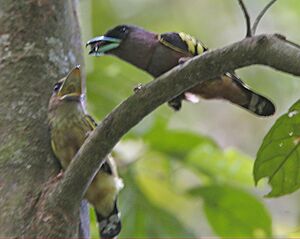
The banded broadbill eats arthropods, small vertebrates, and fruit. Their main food is orthopterans like grasshoppers, katydids, and crickets, which are often about 55 mm (2.2 in) long. They also eat true bugs, snails, spiders, and beetles. Small fruits, like Ficus figs, are also part of their diet. They have been seen eating lizards up to 10 cm (3.9 in) long and frogs, usually swallowing them head-first.
Like other broadbills, they forage slowly. They have a special beak tip and spend most of their time "still-hunting." This means they sit on high branches and then fly out to grab prey from nearby branches or the undersides of leaves. They usually stay very still, except for probing head movements, often looking upwards. They have also been seen making quick, fluttering flights to pick up prey before landing again. Sometimes, they catch prey in flight. Pairs or small family groups are active all day. They sometimes join mixed groups of different bird species looking for food.
How They Breed
On the Malay Peninsula, banded broadbills usually breed during the dry season. In Peninsular Malaysia, nests have been seen in February and March. This suggests that eggs are laid from March to May and in July. The breeding season is longer on the Greater Sunda Islands, lasting from March to November. On Borneo, adults have been seen collecting nesting material in March. In Java, the species might breed all year round, with nests found in April, June, and December.
Like other broadbills, their nests are usually built 6–21 m (20–69 ft) high, hanging over clearings or water. They hang from dead or living trees. Nests have also been found on epiphytes (plants that grow on other plants), ferns, and bamboo. The nests are often built close to beehives, which might help protect them. Both male and female birds help build the nest.
The nests are large, messy, and oval or pear-shaped, measuring 75–90 cm (30–35 in) long, including a trailing "tail." They use leaves, twigs, roots, fibers, moss, and grass stems to build the nest. The inside is covered with leaves and thick grass stems. The outside is decorated with lichen, moss, insect droppings, cocoons, and cobwebs. This helps to camouflage the nest. The entrance to the nest is covered by a slanting "eave."
The eggs are oval-shaped and measure 26.1–31.5 × 17.1–22.2 mm (1.03–1.24 × 0.67–0.87 in). They are smooth and slightly shiny. Usually, they are dull white with dark purple or reddish-brown spots. Eggs from West Java are dirty white with rusty-brown to lavender-grey markings. They usually lay two or three eggs, but sometimes more. Not much is known about how the eggs hatch or how parents care for their young. However, parents continue to feed their young for many weeks after they leave the nest.
Status and Conservation
The International Union for Conservation of Nature (IUCN) considers the javanicus subspecies of the banded broadbill to be near-threatened. All other subspecies are listed as least concern. While javanicus is not found everywhere and is rare in central and eastern Java, it has been seen in some protected areas like Mount Gede Pangrango National Park. Its population is likely less than 10,000 adult birds and is thought to be decreasing. Threats to this subspecies include habitat loss and the cagebird trade.
The other subspecies are generally uncommon to locally common across their range. However, they are rare in Brunei and very rare in northern Thailand. The populations living in the Malay Peninsula are also considered near-threatened. These birds are found in several protected areas, which helps their survival.




